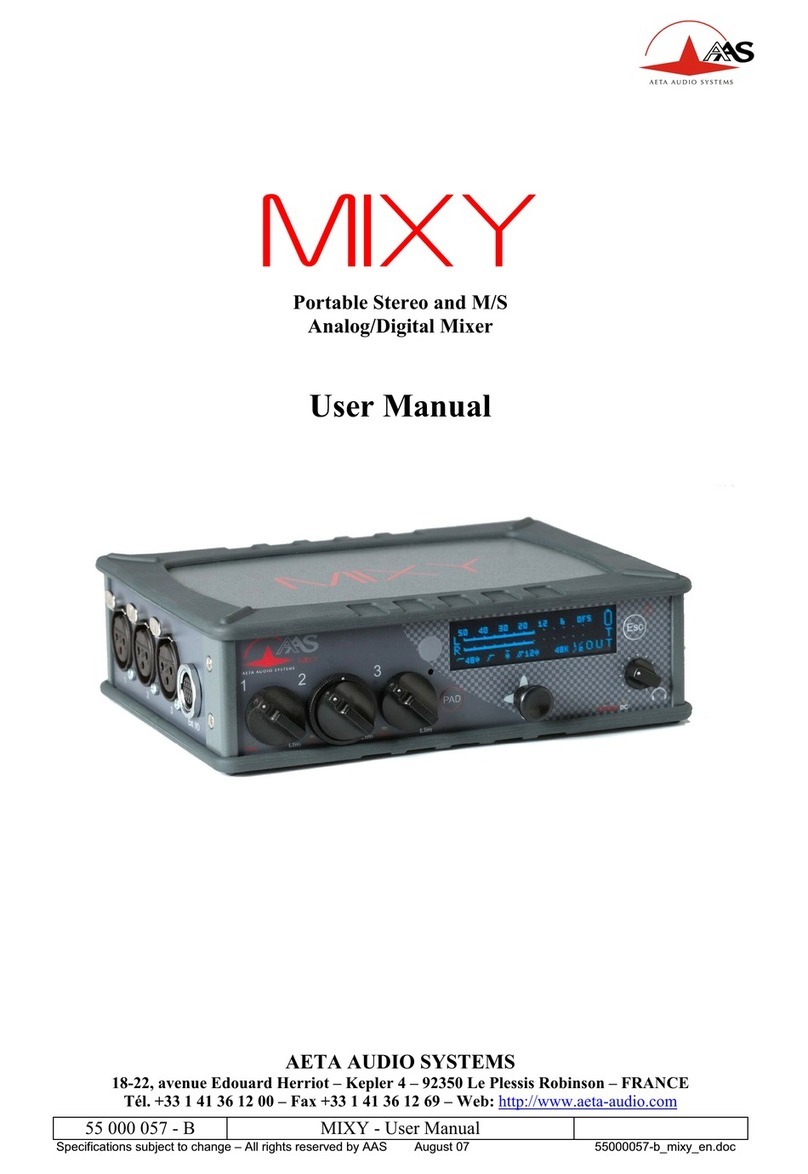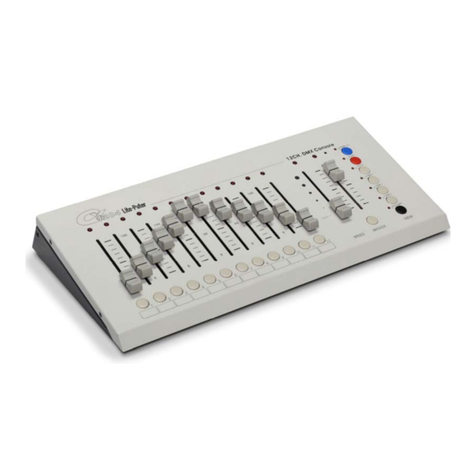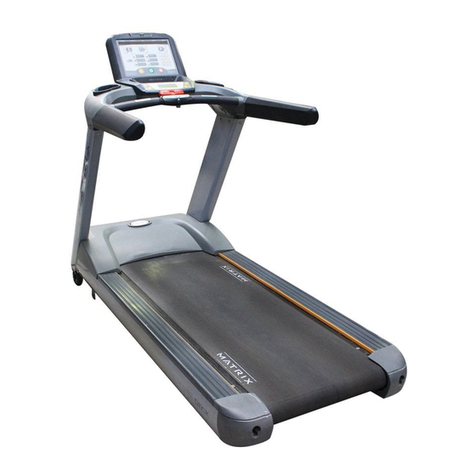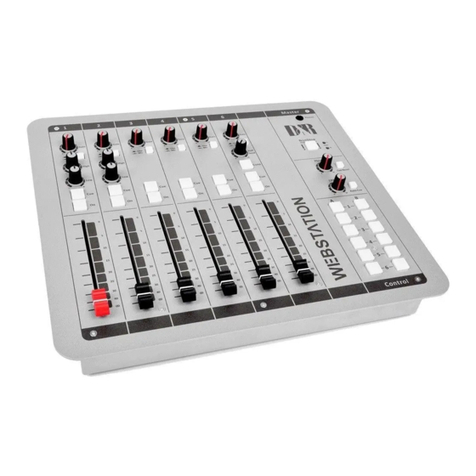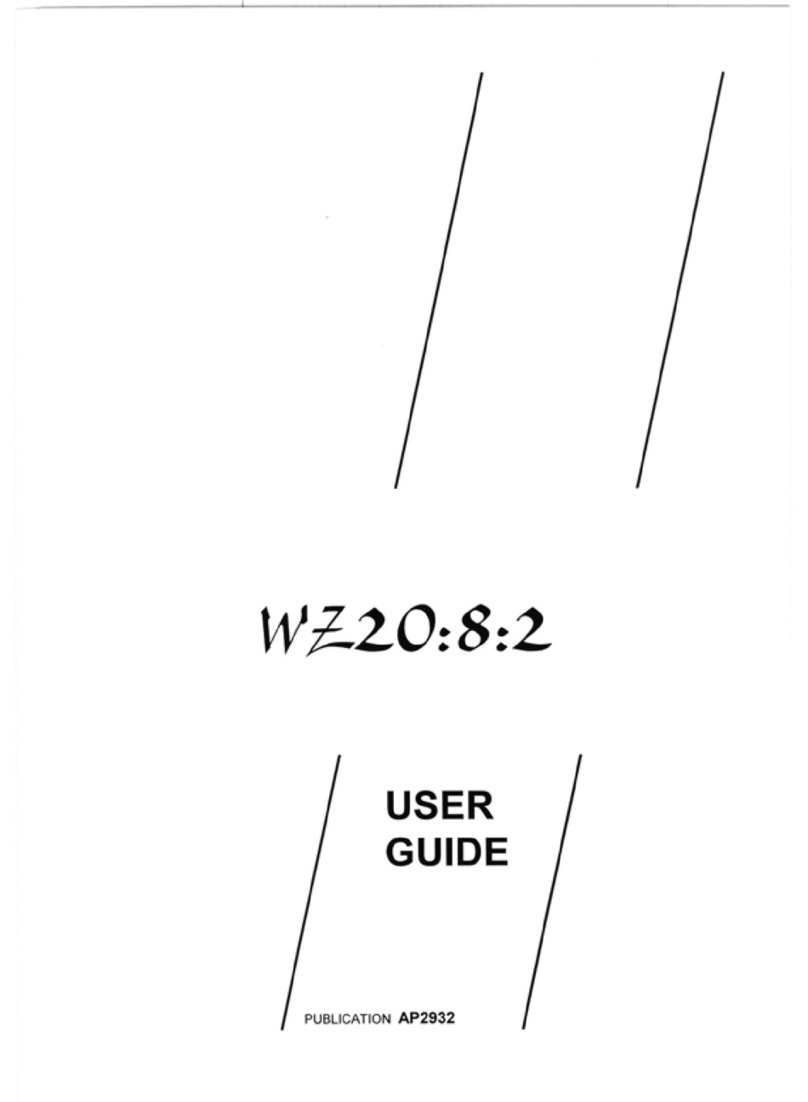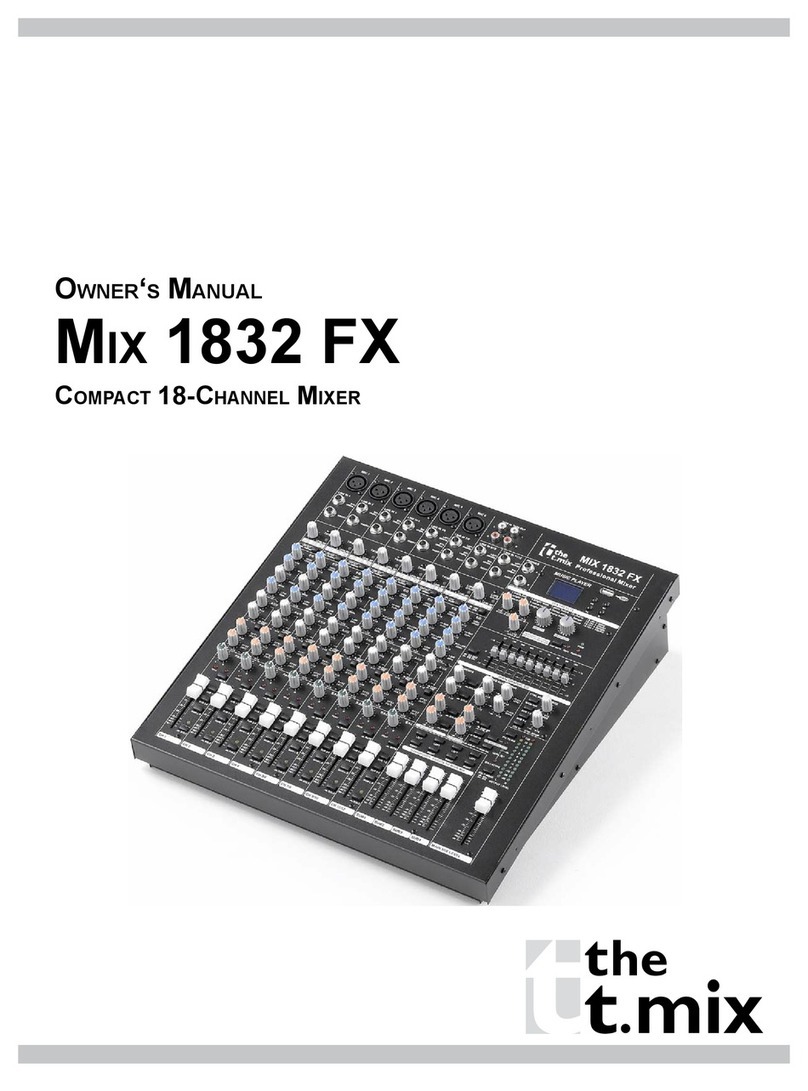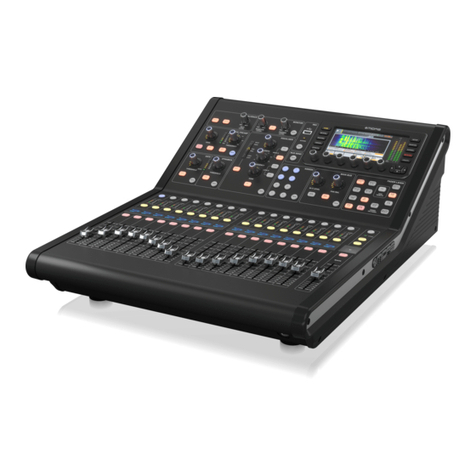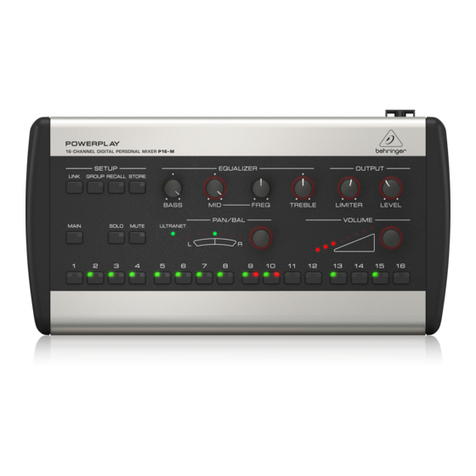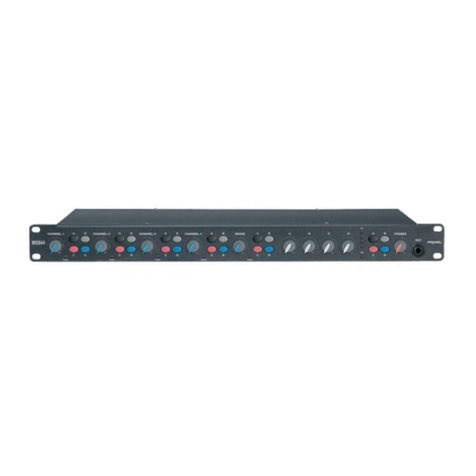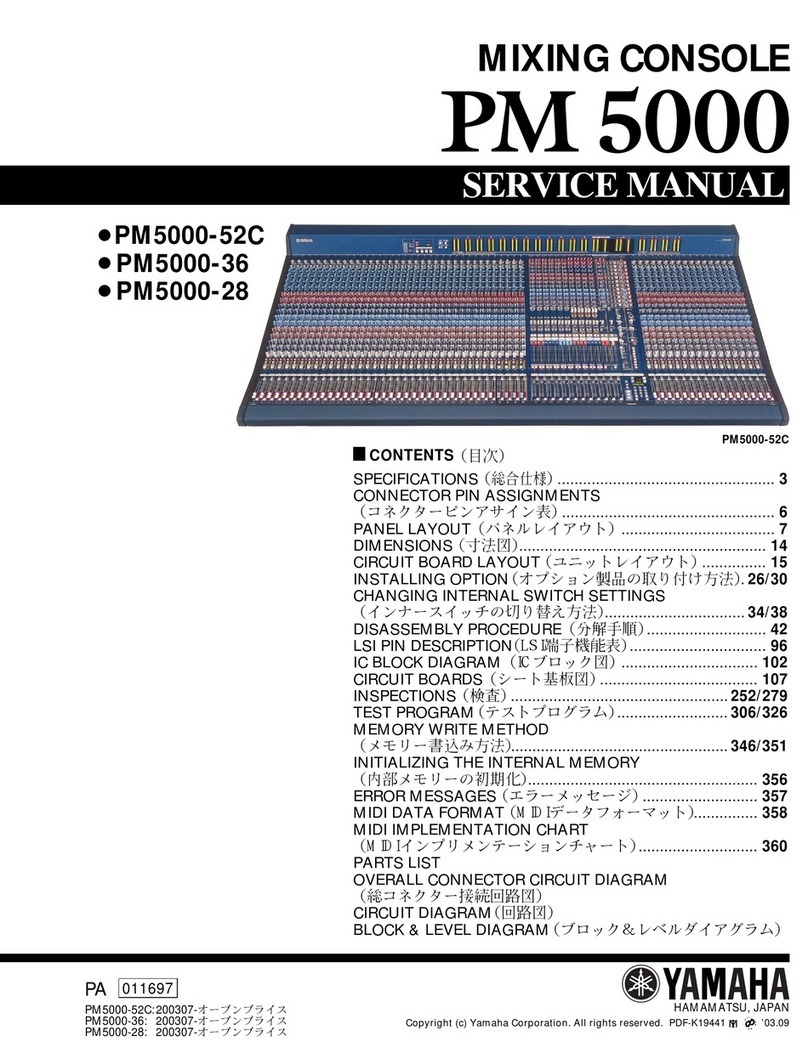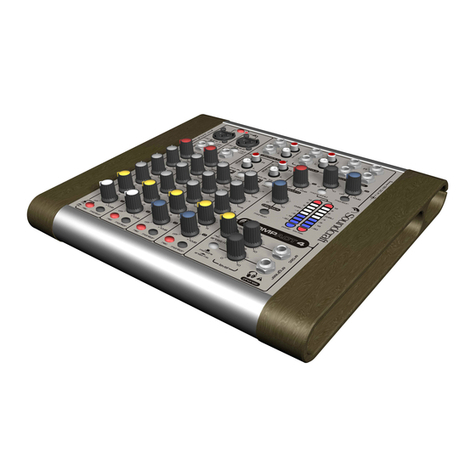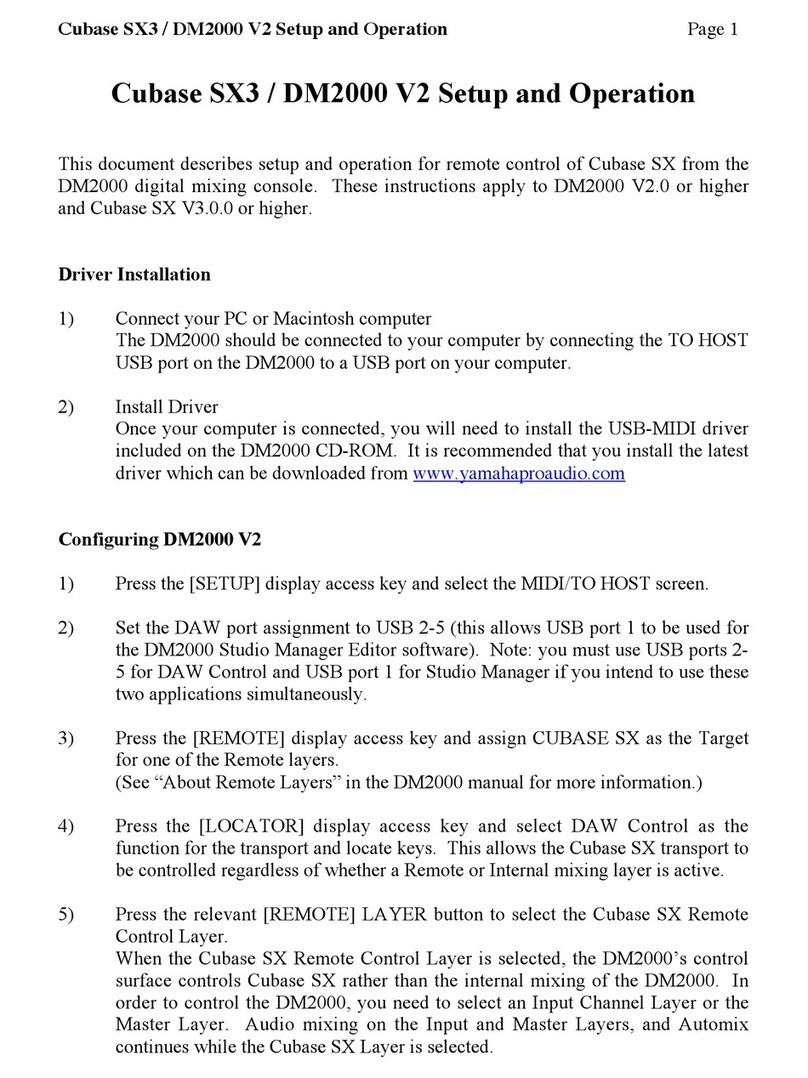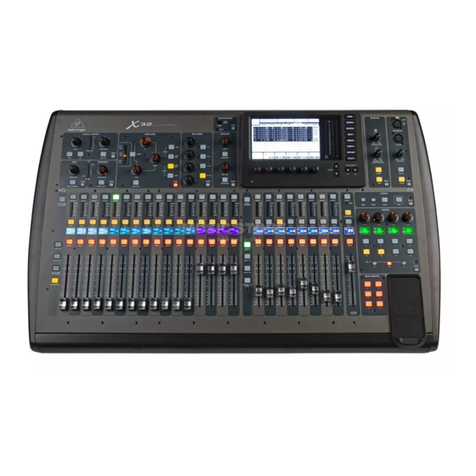Aeta Audio Systems MIX2000 User manual

55 000 015 – Ed. E Mix2000 – User Manual
This document is the property of AETA and can not be duplicated without authorisation February 2001 Manuel Mix2000 (E) - Ed. E.doc
MIX2000
4 inputs portable mixer
User Manual
AETA AUDIO
361, avenue du Général de Gaulle – 92140 Clamart – FRANCE
Tél. +33 (0)1 41361212 – Fax +33 (0)1 41361213 – Telex 631178
Web : http://www.aetausa.com

55 000 015 – Ed. E Mix2000 – User Manual
This document is the property of AETA and can not be duplicated without authorisation February 2001 Manuel Mix2000 (E) - Ed. E.doc
Table of contents
1. Introduction .......................................................................................................................1
2. Functions ............................................................................................................................1
2.1. Input stages ................................................................................................................................... 1
2.2. Input channel processing .............................................................................................................. 1
2.3. Main channels (MASTER)........................................................................................................... 1
2.4. Outputs (MAIN and SUB)............................................................................................................ 2
2.5. Monitoring .................................................................................................................................... 2
2.6. Internal oscillator.......................................................................................................................... 3
2.7. Slate .............................................................................................................................................. 3
2.8. Monitor (MON) ............................................................................................................................ 3
2.9. Power supply ................................................................................................................................ 4
2.10. Miscellaneous ............................................................................................................................. 4
2.11. Digital output (option) ................................................................................................................ 4
3. Operating mode – Detailed description...........................................................................5
3.1. Left panel: “Inputs” ...................................................................................................................... 5
3.2. Front panel.................................................................................................................................... 6
3.3. Adjusting the bar-graph display.................................................................................................... 9
3.4. Right panel: “Outputs” ............................................................................................................... 10
3.5. Replacing the batteries................................................................................................................ 11
3.6. Using L/R <-> M/S matrixing .................................................................................................... 12
4. First level maintenance – Internal configuration .........................................................14
4.1. Internal description ..................................................................................................................... 14
4.2. Internal configuration (switches and jumpers) ........................................................................... 15
4.3. Internal adjustments.................................................................................................................... 18
5. Technical characteristics ................................................................................................21
5.1. Interface characteristics .............................................................................................................. 21
5.2. Internal characteristics................................................................................................................ 27
5.3. System performance ................................................................................................................... 27
5.4. Power supply .............................................................................................................................. 28
5.5. Dimensions and weight............................................................................................................... 28
5.6. Environment ............................................................................................................................... 28
5.7. Versions – Options ..................................................................................................................... 29
5.8. Accessories ................................................................................................................................. 29
6. Annexes ............................................................................................................................30
6.1. Overview of the M/S stereo technique .......................................................................................30
6.2. General synoptic diagram ........................................................................................................... 32
6.3. Gain and level diagram............................................................................................................... 33

55 000 015 – Ed. E Mix2000 - User Manual 1
This document is the property of AETA and can not be duplicated without authorisation February 2001 Manuel Mix2000 (E) - Ed. E.doc
1. Introduction
The MIX2000 is a portable mixer designed especially for outdoor recording (ENG). It is adequate for
cinema production as well, thanks to its audio performance and its M/S format handling capabilities.
The mixer features four symmetrical microphone/line inputs with microphone powering, and a stereo
output with limiter/compressor.
As noticeable highlights, the mixer features:
• Low weight and size (2 kg, 240 x 190 x 43 mm)
• Ultra-low noise (-126 dBu)
• Outstanding input headroom (56 dB)
• Fully M/S compatible
• VCA controlled master stage with selectable compressor and limiter
• 4 symmetrical inputs with selectable high-pass filters
• Wide scale LED bar-graphs with adjustable brightness
• High performance headphone amplifier with source and listening mode selection
2. Functions
The general synoptic diagram shows the functions of the mixer. It can be found in annex 6.2, General
synoptic diagram (page 32).
2.1. Input stages
Each input is symmetrical, transformer coupled.
Microphone powering can be inserted, in phantom mode or “ton-adder” mode1(12V). In phantom mode,
the power supply is 12V or 48V (internally configurable).
Line level is supported thanks to a –26 dB pad. For a microphone input, the input gain is adjustable by
6 dB steps over a 42 dB range.
2.2. Input channel processing
Each channel can be applied a selectable 12 dB/octave high-pass filter (Off / 80 Hz / 120 Hz cut-off
frequency), and phase inversion.
An LED indicates possible channel overload.
The channel feeds the two mixer buses through a channel fader and a panoramic potentiometer.
Each channel pair (1-2 or 3-4) can be coupled so that the even-numbered channel fader simultaneously
controls the level for both channels.
2.3. Main channels (MASTER)
The mixer buses feed the main outputs through VCA-based fader and balance adjustments.
1Not available on some equipment versions

55 000 015 – Ed. E Mix2000 - User Manual 2
This document is the property of AETA and can not be duplicated without authorisation February 2001 Manuel Mix2000 (E) - Ed. E.doc
A limiter or compressor can be inserted in the Master channel. This limiter/compressor features two
selectable operating modes:
• Normal stereo mode, where the limiter/compressor applies same gain to both mixing buses;
• “Independent” mode, where each channel is processed separately, to be used when the main
outputs are used as two mono outputs. This mode can be selected by changing the internal
configuration (for such change, refer to chapter 4.2).
2.4. Outputs (MAIN and SUB)
The Master channels are available in symmetrical format on the MAIN outputs, with a –60 dB pad
separately selectable on each output.
The mixer buses are available in asymmetrical format on the SUB outputs, with a selectable –60 dB pad.
The output gain is adjustable in 6 dB steps thanks to a 6 position switch (0 to –30 dB attenuation from
normal gain).
It is possible to encode the MAIN outputs in M/S format (or decode to L/R stereo if the mixer is used for
recording with M/S stereo microphones). In such case, matrixing is applied as follows:
“Left” MAIN output = MAIN L + MAIN R (where MAIN L/R are the signals before matrixing)
“Right” MAIN output = MAIN L - MAIN R
2.5. Monitoring
A signal in the mixer can be selected for stereo monitoring on a headphone and a programme level meter.
The monitored signal can be selected among the following sources:
• Inputs 1 and 2;
• Inputs 3 and 4;
• SUB outputs;
• MAIN outputs;
• Return signal (from the “Monitor” interface).
In addition, a Solo push-button on each input channel enables direct pre-fader listening of this input.
When pressing the Solo button, the signal is monitored in mono mode (signal sent to both ears and both
meter channels).
The level meter is a wide scale (-40 to +8 VU) two-channel bar-graph display, on 16 LED per channel.
Depending on the internal configuration of the mixer, the level detection has VU or PPM ballistics. In
both cases, two level display modes are available:
• In the standard mode, the level is displayed in bar-graph (“thermometer”) mode, and the last peak
is held for a while on a separate dot (“peak-hold” function);
• In the “dot-only” mode, only the last peak is displayed (peak-hold). This mode can be used e.g.
for getting a more discreet display.
The level display also has adjustable brightness.

55 000 015 – Ed. E Mix2000 - User Manual 3
This document is the property of AETA and can not be duplicated without authorisation February 2001 Manuel Mix2000 (E) - Ed. E.doc
Various listening modes are available on the headphone output:
• Normal stereo or reverse stereo;
• Right signal only or left signal only on both ears;
• Mono (left/right summing) mode, for checking mono compatibility, phase coherence, etc.
Last, M/S↔L/R matrixing can be used for monitoring. This is used for listening to a normal stereo signal
in the headphone while using M/S microphones1. As an alternate use, when the mixer is operated in
normal L/R stereo mode, M/S encoding of the monitored signal can be used for checking the stereo
correlation (checking the “S” signal level in relation with the “M” signal level).
Whenever used, matrixing is applied as follows:
“Left” matrix output = SIG L + SIG R (SIG L/R are the monitored signals before matrixing)
“Right” matrix output = SIG L - SIG R
2.6. Internal oscillator
An internal stereo oscillator is available for sound checking and alignment. The oscillator frequency is
1000 Hz on the left and 400 Hz (intermittent) on the right. By internal configuration, it is possible to have
1 kHz both on left and right channels. It is also possible to make the right signal permanent.
2.7. Slate
A talkback microphone, integrated in the mixer, can be used for inserting the operator’s voice on a mixer
output. Depending on the internal configuration of the mixer, the slate signal is inserted on one (or more)
of the following outputs:
• Left MAIN output;
• Left SUB output;
• Output to RF transmitter;
• Left MON output.
2.8. Monitor (MON)
The mixer features a MONITOR interface, typically used for intercommunication with a camcorder or a
control room (outside broadcasting applications, ENG). This interface includes the following signals:
• Stereo “MON OUT” output (MAIN signal);
• Stereo “MON Return” signal (input to the mixer for monitoring);
• Slate signal (output);
• “On-air” control input.
1If the MAIN signal has been applied M/S↔L/R matrixing at the output, the MAIN signal is automatically monitored with M/S
decoding, because the signal is picked up after the M/S↔L/R matrix.

55 000 015 – Ed. E Mix2000 - User Manual 4
This document is the property of AETA and can not be duplicated without authorisation February 2001 Manuel Mix2000 (E) - Ed. E.doc
2.9. Power supply
The mixer operates from disposable or rechargeable batteries (8 AA-size batteries). It can be operated
from an external DC source as well.
The mixer can automatically switchover from one power source to the other, with no interruption or
noise.
2.10. Miscellaneous
The mixer includes a dedicated output for feeding a wireless RF transmission device, including power
supply for the RF transmitter.
Lastly, extension interfaces are available for coupling two (or more) MIX2000 mixers together, for e.g.
increasing the number of inputs.
2.11. Digital output (option)
The MIX2000 can be optionally1equipped with an analogue to digital converter (24 bit resolution). This
module converts the MAIN output signals and outputs a stereo digital signal, selectable in AES/EBU
format or SPDIF (IEC958).
The analogue MAIN outputs are still available when the “digital output” option is installed.
1This option is not displayed on the synoptic diagram

55 000 015 – Ed. E Mix2000 - User Manual 5
This document is the property of AETA and can not be duplicated without authorisation February 2001 Manuel Mix2000 (E) - Ed. E.doc
3. Operating mode – Detailed description
3.1. Left panel: “Inputs”
This panel includes the input connectors and input settings. The “Monitor” interface is also available on
this side, including the interface connector and a potentiometer for adjusting the Monitor Return gain.
Figure 1 - Left panel – Inputs and Monitor interface
The following elements are available for each input:
• Input connector: female XLR;
• Microphone power selection switch: Dyn (dynamic microphone or line level); Ph. (phantom
power supply), T12V1(“Tonadder”);
• Pad switch;
• Input gain selection switch, with 8 positions.
Figure 2 - Input settings
1This selection is not available on some versions

55 000 015 – Ed. E Mix2000 - User Manual 6
This document is the property of AETA and can not be duplicated without authorisation February 2001 Manuel Mix2000 (E) - Ed. E.doc
3.2. Front panel
The front panel includes the following zones, starting from the left:
• Input channels;
• Master section;
• Monitoring section
3.2.1. Input channels
The following picture shows the elements for channels 3 and 4, as an example.
Figure 3 - Input channels (3 and 4)
Notes:
• When the fader coupling switch is set in the rightmost position, channel fader #4 sets the gain for
both channels simultaneously, and channel fader #3 is inoperative. Of course, the same holds for
the “1+2” fader coupling switch with (respectively) fader #2 and fader #1.
• When pushing the SOLO button on a channel, the corresponding input signal is sent to both
monitoring channels, overriding the current monitoring source selection.
• The coloured text on the bottom reminds the panning of the input, depending whether the mixer is
operated in normal stereo mode (L/R green text) or in M/S mode (M/S red text).

55 000 015 – Ed. E Mix2000 - User Manual 7
This document is the property of AETA and can not be duplicated without authorisation February 2001 Manuel Mix2000 (E) - Ed. E.doc
3.2.2. Master section
Figure 4 – Master section
Notes:
• The oscillator produces a continuous 1 kHz sine wave on the left channel and an intermittent
400 Hz sine wave on the right channel1. The oscillator can be activated either temporarily by
sliding up the oscillator switch (“On” position), or permanently by moving down the switch
(“Lock” position).
• When the master fader is set at the reference gain point (and the limiter/compressor is off), the
MAIN output has a 0 VU level when the internal oscillator is set on.
• Note that the master fader is located after the limiter/compressor on the signal chain (see general
diagram on page 32).
• The limiter/compressor is a stereo processor, but it is possible (internal configuration) to select
independent processing of the two channels.
• The MAIN output mode indicator switches to red when L/R↔M/S matrixing is activated on the
MAIN output, while it is green when no matrixing takes place.
1By changing the internal configuration, the right channel can be set at 1 kHz, and it can be permanent (instead of intermittent).

55 000 015 – Ed. E Mix2000 - User Manual 8
This document is the property of AETA and can not be duplicated without authorisation February 2001 Manuel Mix2000 (E) - Ed. E.doc
3.2.3. Monitoring section
Figure 5 – Monitoring section
Notes:
• The “ON AIR” indicator is activated by the “On-air” control signal from the “Monitor” interface
(refer to 2.8, Monitor (MON));
• The M/S switch can be used for optionally matrixing the signal for monitoring, typically for
listening in normal stereo when using M/S microphones (see 2.5, Monitoring). A red LED is on
when the switch is activated. In such case, the action of the mode selector is indicated by red
coloured text near the selector.
• The LED above the power switch lights green when the unit is on. However, the LED flashes red
whenever the batteries are low (less than 8.8 V, or 1.1 V per battery), or the external DC power is
low (less than 12.8 V1).
• The Slate button can be used for activating the talkback microphone. The microphone is located
behind a small cavity in the front panel, just besides the “Slate” button.
• The button below the bar-graphs is used for adjusting the display mode and/or the display
brightness. The following chapter describes the instructions for using this button.
1Note that the threshold is different for the external power

55 000 015 – Ed. E Mix2000 - User Manual 9
This document is the property of AETA and can not be duplicated without authorisation February 2001 Manuel Mix2000 (E) - Ed. E.doc
3.3. Adjusting the bar-graph display
As described above in 2.5, the display brightness is adjustable and two level display modes are available:
• Standard bar-graph mode, with peak hold;
• “Dot-only” mode, where only the last peak is displayed.
The display mode and brightness can be set using the push-button near the display.
3.3.1. Display mode selection
When switched on, the mixer is in standard bar-graph display mode. Shortly pressing the button switches
the display to “Dot-only” mode, pressing it again brings it back to normal mode.
3.3.2. Display brightness adjustment
The display brightness can be adjusted among five intensity levels, from very low intensity (for use in the
dark) to a level high enough to read it in sunlight.
When switched on, the mixer is set with an average brightness. Press and hold down the button in order to
scroll the different brightness levels, by decreasing brightness order. Release the button when the desired
level is reached.
Note: after reaching the lowest level, the cycle resumes from the highest level.

55 000 015 – Ed. E Mix2000 - User Manual 10
This document is the property of AETA and can not be duplicated without authorisation February 2001 Manuel Mix2000 (E) - Ed. E.doc
3.4. Right panel: “Outputs”
Figure 6 – Right panel
Notes:
• The headphone socket is a locking connector for a ¼” jack; for unplugging the jack, remember to
unlock the socket by pressing the button;
• Both SUB and MAIN outputs are available on male XLR sockets. However, only the MAIN
outputs are symmetrical, while the SUB outputs are asymmetrical;
• The SUB pad attenuates both left and right outputs at the same time, while separate pads are
available for MAIN left and right signals;
• M/S matrixing switch: no matrixing when on the “L/R” position. M/S position can be used for
outputting a normal stereo signal while using M/S microphones, or conversely for outputting M/S
encoded signals while using the mixer in normal stereo mode. Note that, when monitoring the
MAIN output, the signal is picked up after the possible matrixing.
• When the mixer is fitted with the digital output option, this output is available on the RF
transmitter link socket. An adapter cord for SPDIF format, included in the option, makes the
signal available on a male RCA plug. Alternatively, it is possible to use an adapter cord for AES
format with a male XLR plug. Plugging the adapter cord on the mixer activates the digital output
module; in order to maximise battery life, it is recommended to disconnect the cord when not
using the digital output.
• The external DC socket accepts a DC supply between 13 V and 16 V. The mixer still operates
correctly at a voltage down to 4 V, but the “battery low” indicator flashes whenever the external
DC voltage is less than 12.8 V.
• The external DC can be plugged in or out at will during operation. Operation is not disturbed
provided there are batteries inside the mixer.

55 000 015 – Ed. E Mix2000 - User Manual 11
This document is the property of AETA and can not be duplicated without authorisation February 2001 Manuel Mix2000 (E) - Ed. E.doc
3.5. Replacing the batteries
The mixer operates from 8 LR/AA-size batteries. The following types can be used:
• Disposable batteries; heavy duty alkaline batteries are highly recommended.
• Rechargeable NiCd or NiMH batteries.
To unlock the battery door, simply twist the door lock a quarter of a turn. Then the door unlocks and half
opens. To open it and release the batteries, slightly push the door (leave the door lock loose).
When inserting new batteries, the correct orientation of the batteries is shown on the back panel (see the +
and – signs inside the battery door as well). To lock the battery door, hold the door closed, and firmly
push the door lock while holding it in the proper orientation (that shown on the photograph below), until
it locks into place. You may also twist the door lock slightly while pushing it.
For proper operation of the mixer:
• Replace all batteries at the same time for new batteries of identical types; do not mix batteries
from different makes or models;
• Check that the batteries are set in their compartment as indicated, with proper orientation;
• Switch off the mixer when the batteries are low and/or the mixer is not in use;
• It is recommended not to leave batteries inside the mixer when it is left unused for a long time.
Possible damage induced by the non observance of the above recommendations is not covered by the
warranty.

55 000 015 – Ed. E Mix2000 - User Manual 12
This document is the property of AETA and can not be duplicated without authorisation February 2001 Manuel Mix2000 (E) - Ed. E.doc
3.6. Using L/R <-> M/S matrixing
This chapter shows examples of situations where L/R↔M/S matrixing can be used and the effect of
matrixing in these situations. Further information about the M/S stereo technique can be found in annex
6.1 (Overview of the M/S stereo technique).
3.6.1. Case 1: standard stereo engineering
This is the most common application. In this case, mono microphones or normal (L/R) stereo microphone
couples are used, and the output of the mixer is in standard stereo format.
L/R↔M/S matrixing is not needed in such an operating mode.
However, L/R↔M/S matrixing may be used occasionally for monitoring, as a way of visually checking
the stereo image consistency on the level meter display. If matrixing the monitored signal, the “left” bar-
graph shows the L+R sum, while the “right” bar-graph shows the L-R difference. For common stereo
production, the L-R level should be much lower than the L+R level, especially when mono compatibility
is desired. On the contrary, L-R level higher than L+R level would warn about a possible problem in
sound pick-up (e.g. one microphone in a stereo couple is phase reversed).
3.6.2. Case 2: stereo recording using MS microphones
In this case, M/S stereo microphone couples are used, and the output of the mixer is in standard stereo
format.
Instead of left and right, the mixer buses actually process M (Mid) and S (Side) signals. In order to output
normal stereo signals, L/R↔M/S matrixing must be applied at the MAIN output (switch on the “M/S”
position). Matrixing is also needed for monitoring a normal stereo signal on the headphones (front panel
switch on the “M/S” position), except for monitoring the MAIN output because it is already decoded to
L/R format.

55 000 015 – Ed. E Mix2000 - User Manual 13
This document is the property of AETA and can not be duplicated without authorisation February 2001 Manuel Mix2000 (E) - Ed. E.doc
3.6.3. Case 3: MS recording using MS microphones
In this case, M/S stereo microphone couples are used, and the output is kept in M/S format for recording.
In this way, further stereo image processing is made possible with studio equipment in later production.
The mixer buses process M (Mid) and S (Side) signals. L/R↔M/S matrixing is not applied at the MAIN
output (switch kept on the “L/R” position). Matrixing is needed for monitoring a normal stereo signal on
the headphones (front panel switch on the “M/S” position).
3.6.4. Case 4: MS recording using classical microphones
In this case, mono microphones or normal (L/R) stereo microphone couples are used, but the output is
encoded in M/S format for recording. In this way, further stereo image processing is made possible with
studio equipment in later production.
In order to encode the outputs in M/S format, L/R↔M/S matrixing is applied at the MAIN output (switch
on the “M/S” position). Matrixing is not needed for monitoring a normal stereo signal on the headphones,
except for monitoring the MAIN output, which is encoded in M/S format.

55 000 015 – Ed. E Mix2000 - User Manual 14
This document is the property of AETA and can not be duplicated without authorisation February 2001 Manuel Mix2000 (E) - Ed. E.doc
4. First level maintenance – Internal configuration
4.1. Internal description
The following diagram shows the organisation of the mixer, as can be seen from the bottom side if the
bottom cover is removed.
Figure 7 – Internal organisation (view from the bottom)
The main part of the mixer is the motherboard, mounted on the top of the mixer, parallel to the top cover.
Various daughterboards and modules are connected to the motherboard:
• Front panel assembly, including all front panel control and display elements;
• Input module on the left side;
• Output module on the right side;
• Monitoring and slate1daughterboards mounted directly upon the motherboard.
For easy replacement, the potentiometers are mounted on small daughterboards attached to the front panel
module.
1When the digital output is installed, the slate daughterboard also includes the analogue to digital converter and the digital output.

55 000 015 – Ed. E Mix2000 - User Manual 15
This document is the property of AETA and can not be duplicated without authorisation February 2001 Manuel Mix2000 (E) - Ed. E.doc
4.2. Internal configuration (switches and jumpers)
Most configuration elements are available on the top side of the motherboard. However, a few elements
can be accessed from the bottom side.
Warning: whenever opening the unit, only use adequate tools, and take all
necessary care to avoid electrostatic discharges (ESD) in the unit. Damage to the
internal parts due to non observance of these precautions is not covered by the
warranty.
4.2.1. Top side configuration elements
For accessing the elements, remove all screws on the top and put the top cover aside. The motherboard
appears as on the following picture. The jumpers and switches are shown with the effect of each position.
Figure 8 – Internal configuration – top side view
Notes:
• The phantom power voltage can be configured 48 V or 12 V separately for each input.
• Depending on the position of the corresponding jumper, the power output to the RF transmitter is
either a regulated +9 V supply or directly the battery power (or the external DC source when
available).
When remounting the cover, please check that the flanges are well engaged inside the top cover grooves
before tightening the screws.

55 000 015 – Ed. E Mix2000 - User Manual 16
This document is the property of AETA and can not be duplicated without authorisation February 2001 Manuel Mix2000 (E) - Ed. E.doc
4.2.2. Bottom side
For accessing the elements, remove all screws on the bottom and put the bottom cover aside1. The
motherboard appears as on the following picture. The jumpers are shown with the effect of each position.
Figure 9 – Internal configuration – bottom side view
Notes:
• Slate signal insertion: the jumper must be set on one among the four allowed positions (or none of
them in order to disable the slate function). It is also allowed to select more than one position, as
the signal is injected on each output for which the corresponding jumper is set on.
• Please also refer to following chapter 4.2.3 in case the mixer is equipped with a digital output.
• Do not move other jumpers than those described above.
When remounting the cover, please check that the flanges are well engaged inside the cover grooves
before tightening the screws.
1Caution: only remove one cover at a time.

55 000 015 – Ed. E Mix2000 - User Manual 17
This document is the property of AETA and can not be duplicated without authorisation February 2001 Manuel Mix2000 (E) - Ed. E.doc
4.2.3. Configuration of the digital output option
In a MIX2000 featuring a digital output, the “Slate” module (top right on Figure 9 above) also includes
the analogue to digital converter and the digital output. The configurable elements on this module appear
as shown on the following drawing.
Figure 10 – Configuration of the optional “Slate and digital output” module
(In the example shown, the Slate signal is inserted on the left MAIN output, and the digital output is AES
professional format at 48 kHz sampling rate)
The selection of the slate signal insertion point can be found on this module; the jumper must be set on
one or more of the available positions (or none if the function is not desired).
The other jumpers select the format of the digital output. The sampling rate can be set at 44.1 kHz or
48 kHz. Besides, the SPDIF/PRO jumper selects the frame format of the digital output:
• “SPDIF”: consumer format, SPDIF or IEC958.
• “PRO”: professional format, compliant with AES3 recommendation;
The proper selection depends on the application. The following table shows the allowed combinations as
well as some typical applications. The table also shows the external adapter cable (and hence the output
plug) to use, to be consistent with that combination.
Frame
format
Sampling
rate Application examples
Adapter
cord
to be used
44,1 kHz Recording on a portable DAT or MD recorder RCA1
SPDIF 48 kHz
44,1 kHz Recording on a DAT device
PRO
(AES) 48 kHz Recording (professional equipment)
Connection to a digital mixing console
XLR
Please note that the 44.1 kHz sampling rate must be selected with the SPDIF consumer format. Also note
that using a cord other than recommended produces an incorrect format (e.g. SPDIF frame format with
AES electrical format on an XLR plug), which leads to unpredictable results on the equipment connected
at the output.
1This adapter cord is delivered with the digital output option

55 000 015 – Ed. E Mix2000 - User Manual 18
This document is the property of AETA and can not be duplicated without authorisation February 2001 Manuel Mix2000 (E) - Ed. E.doc
4.3. Internal adjustments
Warning: all adjustments in the mixer are done on the factory, and should need no later changes. Only
qualified personnel should change these adjustments. For access to the adjustable elements, follow the
same instructions as for the internal configuration described in the previous chapter.
4.3.1. Top side
Most adjustments are accessible from the top, as visible on the following picture:
Figure 11 – Internal adjustments – top side view
Function Reference Adjustment
P2 Input symmetry (Channel 1)
P1 Input symmetry (Channel 2)
P4 Input symmetry (Channel 3)
Input symmetry adjustment
(Common mode rejection)
P3 Input symmetry (Channel 4)
P6 Balance centre point
P8 Compression ratio (left)
P17 Compression ratio (right)
Master VCA adjustments
P9 Limiter/compressor threshold
P5 THD (Left)
P7 THD (Right)
P13 Output common mode (Left)
MAIN outputs
P12 Output common mode (Right)
P18 Oscillator level (left)
Oscillator
P14 Oscillator level (right)
+9 V supply (for RF transmitter) P16 Voltage adjustment
Table of contents
Other Aeta Audio Systems Music Mixer manuals

